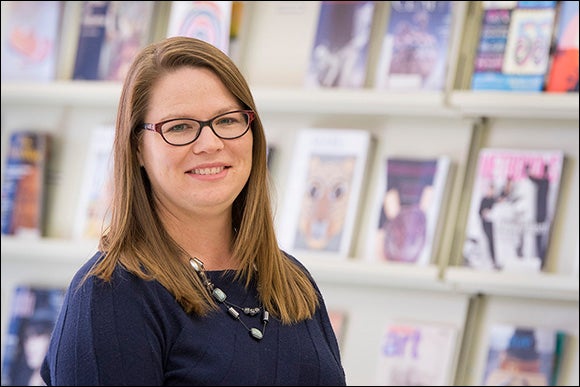ENHANCING USER EXPERIENCE
ECU graphic design program trains graduates to transform technology
In 2013, Clay Braxton graduated from East Carolina University with a bachelor of fine arts in art with a concentration in graphic design. Today he works for IBM, a world leader in technology and the integration of hardware, software, business consulting and information technology services.
The design-uninitiated may ask how a person with a degree in graphic design melds with engineers on a strategic software production team at one of the technology industry’s foremost companies.

Clay led exercises for a design class conducted by Kate Lamere, ECU professor of graphic design, pictured above.
The answer? Perfectly. As it turns out, IBM is seeking the mindset artist-designers possess to better identify and meet the needs of its users and consumers. And developing that mindset is part of the design curriculum at ECU.
Braxton could have chosen a traditional graphic design career path—creating websites, identity systems or marketing materials. Instead, he chose to be part of an innovative $100 million IBM initiative to use the principles of the art and design process to expedite problem discovery, problem solving and collaboration at the technology giant. The goal is to enhance the end-user experience for all IBM products by creating a human-centered professional culture called “IBM Design Thinking,” resulting in a flow of information to the consumer that is easily navigable and usable.
As a design team lead in digital commerce with two squads of designers, Braxton is on the front lines of the implementation of IBM’s commitment to agile, humanized development, and the recruiting and training of other designers. In addition, he is a section lead for DesignCamp, IBM’s intensive training and orientation for newly-hired designers, after being a DesignCamp participant two years prior.
After graduating from ECU, Braxton began working at IBM’s first design studio in Austin, Texas, before relocating to IBM Research Triangle in September.
“I began at IBM in June of 2013 as part of the inaugural class of IBM Design, of which approximately 60 of us participated in a three-month intensive DesignCamp for new hires,” Braxton said. “I worked for two years as a visual designer and also did visual strategy, user experience design and design research before becoming a digital commerce design team lead.”
Braxton earned an undergraduate degree in multi-disciplinary studies with a concentration in visual art before coming to ECU for his bachelor of fine arts. He also worked in the retail industry for Pottery Barn and Banana Republic, and the North Carolina Museum of Life and Science and Marbles Kids Museum, experiences he credits for enhancing his understanding of the consumer. However, the broad visual arts curriculum at ECU, he said, was integral to fostering his ability to do the high-level systems-thinking and the detail work IBM requires.

ECU design student Daniel DiPiero participates in exercises led by ECU graduate and IBM staffer Clay Braxton.
“Concept work and theory at ECU were instrumental in my ability to wrap my head around the complexity of IBM software, which is software that deals with some of the most complex and significant problems the world faces today,” he said.
“Much of the work done at ECU has impacted my ability to design at IBM, including graphic design classes, branding and typographic theory, graphic theory, design research, front end coding, and all of the supplemental visual arts courses including philosophy of art and figure drawing.”
Braxton returned to ECU in September and conducted DesignCamp exercises with ECU students in a design class.
“Clay led an exercise that allowed students to think quickly while addressing a real-world design problem,” said Kate Lamere, ECU professor of graphic design. “Students experienced how to apply design research methods we had been discussing in a context that approximated practice.”
IBM expects to hire 1,000 designers over a five-year period, increasing the ratio of designers to engineers from 1-to-66 to 1-to-16.
IBM Design is headquartered in Austin (with approximately 500 designers), with a mission to identify, train and equip top design talent. IBM Design satellite studios are located in Dublin, Shanghai, and New York, with new studios planned for Hursley, England; Research Triangle Park, NC; Boeblingen, Germany; San Francisco and others.
Pictured below, left to right, design students Kevin Sanderson, Jordan Colston and Thomas Davis are intent on solving real-world design problems during Clay’s presentation.
